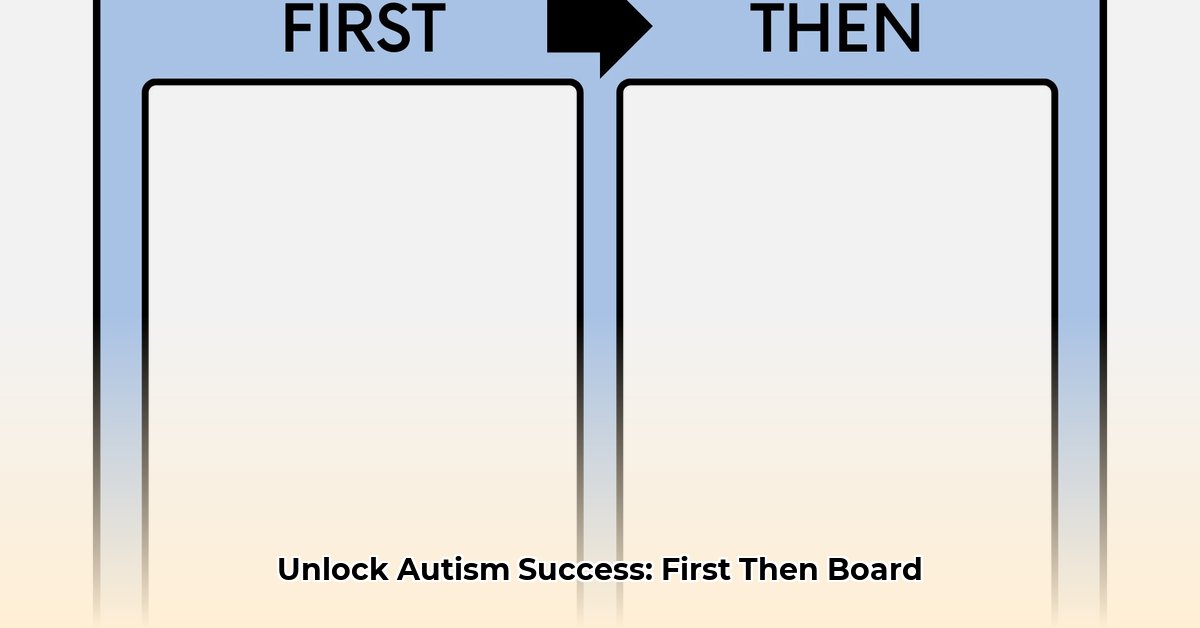Are you looking for effective ways to manage meltdowns, ease transitions, and boost cooperation? First-then boards are a powerful visual tool that can significantly benefit children on the autism spectrum, and even those with other learning differences! This comprehensive guide will provide you with a thorough understanding of first-then boards, offering step-by-step instructions for creating and using them, practical tips from experienced educators and therapists, and inspiring real-life examples. Discover how this simple strategy can empower your child or student, fostering confidence, independence, and a greater sense of control.
First-Then Boards: Unlocking Potential in Autism Support
First-then boards serve as valuable tools for supporting children, especially those with autism. These user-friendly visual schedules clearly present what needs to be done first, followed by what comes then, creating a predictable and rewarding sequence. By providing structure and visual clarity, first-then boards empower children to understand expectations, complete tasks, and navigate transitions with greater ease and reduced anxiety. Overall, first-then boards enhance visual learning.
- Establish clear expectations, minimizing confusion and anxiety.
- Promote consistent adherence to routines and schedules.
- Offer visual support to enhance comprehension and cooperation.
- Increase motivation by associating tasks with desired outcomes.
Decoding First-Then Boards: A Straightforward Explanation
Imagine being asked to tackle a less-than-desirable task, like cleaning your room. A first-then board simplifies this process by visually illustrating that first, the task is completed, then, a rewarding activity follows. This technique is rooted in the Premack Principle, which involves using a preferred activity as a motivator or reward for completing a less-preferred activity. This visual strategy can build cooperation and reduce anxiety. For children with autism, the predictability and clear structure inherent in first-then boards can significantly reduce anxiety.
Crafting a Personalized First-Then Board: A Detailed Guide
Creating an effective first-then board doesn’t need to be complicated. Here’s a detailed guide to help you create a board designed to suit your child or student’s unique requirements:
Step 1: Select Comprehensible Visuals. Opt for clear photographs or easily recognizable symbols that resonate with your child. Generic icons may be confusing. Consistent use of the same visuals for specific activities is essential.
Step 2: Start Small and Simple. Introduce one or two steps initially, gradually adding more as your child becomes comfortable. Avoid overwhelming them with too many expectations at once.
Step 3: Identify Motivating Rewards. Collaborate with your child to identify activities or items they genuinely enjoy. Allowing them to participate in reward selection increases their engagement. Rewards don’t need to be extravagant, but they should be meaningful.
Step 4: Ensure Clarity and Simplicity. Use concise language, avoiding complex sentences or excessive wording. Clarity is crucial for understanding.
Step 5: Maintain Consistency. Consistency is paramount. Ensure that the “then” reward is consistently provided upon completion of the “first” task. This builds trust and reinforces the system’s reliability.
Step 6: Adapt and Adjust. Regularly review and adapt the board to align with your child’s evolving preferences and abilities. What motivates a child at one stage may not be as effective later.
Step 7: Celebrate Success. Acknowledge and celebrate every accomplishment, both big and small. Positive reinforcement fosters motivation and makes the process more enjoyable.
First-Then Board Scenarios
Review simple first then board scenarios :
| First | Then |
|---|---|
| Complete five minutes of homework | Play a favorite video game |
| Help with setting the table | Listen to a story |
| Practice writing name three times | Have a snack |
Enhancing Complexity Gradually
Introduce additional steps or more challenging tasks incrementally. Monitor your child’s response and adjust accordingly, proceeding at a pace that suits their comfort level. What are strategies for increasing complexity?
Fostering Independence
The ultimate goal is to promote self-reliance. Gradually shift responsibility to your child, encouraging them to use the board independently. Offer support and encouragement, but empower them to manage their own schedule, building self-confidence and self-determination.
Navigating Potential Challenges
While first-then boards are generally effective, some challenges may arise:
- Inconsistent Application: Irregular use of the board can undermine its effectiveness. Commit to consistent implementation to build trust and achieve desired outcomes.
- Unmotivating Rewards: If the “then” activity lacks appeal, the system will fail. Monitor your child’s preferences and adjust rewards accordingly.
- Overly Complex Boards: Too many steps can overwhelm a child. Begin with simple boards and gradually add complexity as their capabilities increase.
Conclusion: A Gateway to Progress
First-then boards are versatile tools, but it’s important to remember that each child is unique. Flexibility, patience, and positive reinforcement are essential. By tailoring the board to your child’s individual needs and celebrating their successes, you can transform first-then boards into a valuable asset in their development. Remember that progress takes time and effort. Embrace the journey and celebrate every milestone along the way.
Transitioning to Student-Managed First-Then Boards: A Guide to Independence
First-then boards are powerful tools! But how do we empower children to use these boards independently? Let’s explore how to effectively transition from teacher-managed to student-managed first-then boards. It’s all about gradually giving the child more control. Visual supports enable independence.
Understanding the Transition
We begin with the teacher guiding the process, then slowly let the child take the reins. The transition to independence may not always be linear. There may be times when a student needs to go back to a more supported level before progressing again.
Steps to Success: A Gradual Handoff
- Start Simple: Begin with a very basic board, maybe just two things: “First” (a short, easy task) and “Then” (a highly preferred activity).
- Visual Cues are Key: Use clear pictures or symbols the child understands. A picture is worth a thousand words, especially for visual learners!
- Model, Model, Model: Show the child how to use the board. Point to the “First” task, then, once completed, move to the “Then” reward. Repeat this process many times.
- Verbal Prompting and Fading: At first, give verbal prompts like “What do we do first?” and “What do we get to do after?” Slowly reduce these prompts as they become more independent.
- Introduce Choices: Gradually add more choices to the “First” and “Then” sections. This empowers the child and builds their decision-making skills. This is a great step toward self-management.
- Self-Monitoring: Once comfortable, encourage the child to point to the next task on their own. Praise their efforts!
- Increased Complexity: Slowly increase the number of tasks on the board. This helps them manage more complex routines and longer-term goals.
- Independence: Encourage the child to independently select tasks and rewards, and manage their board independently.
Troubleshooting Common Challenges
- Resistance: If a child resists using the board, try simplifying it or going back to a previous step. Make sure the “Then” activity is truly motivating.
- Difficulty Understanding: If they don’t grasp the visual cues, try different pictures or symbols. Ensure these visuals accurately reflect their interests and current abilities.
- Lack of Motivation: If the reward isn’t engaging, it’s time to reassess. What does the child truly value?
Key Takeaways:
- Gradual Release of Responsibility: Transitioning from teacher-managed to student-managed boards should be a gradual process. Take small steps and celebrate success.
- Individualized Approach: The approach needs to be tailored to the child’s individual needs and abilities.
- Positive Reinforcement: Positive reinforcement and encouragement will help the child feel confident and motivated.
- Clear Communication: Consistent communication between caregivers, teachers and therapists is key.
- Gluten Free Meal Prep Ideas for Delicious, Hassle-Free Eating - November 28, 2025
- Gluten Free Meal Prep for Stress-Free and Healthy Eating - November 27, 2025
- Quick And Easy Chicken Thigh Meal Prep For Weight Loss - November 26, 2025










